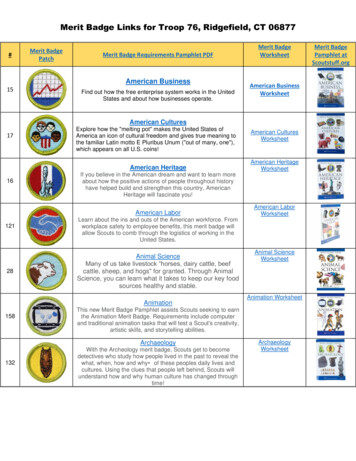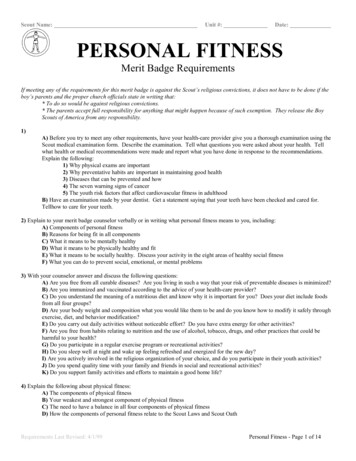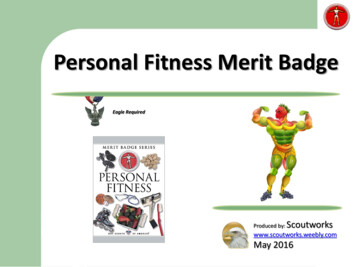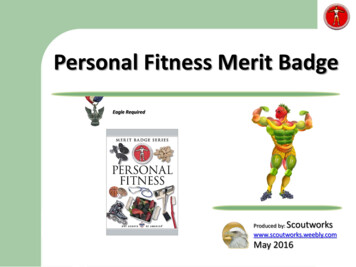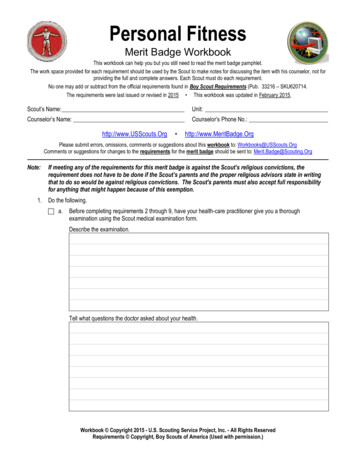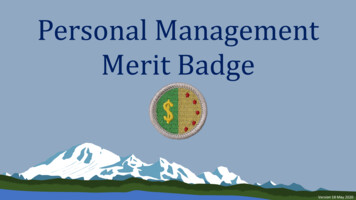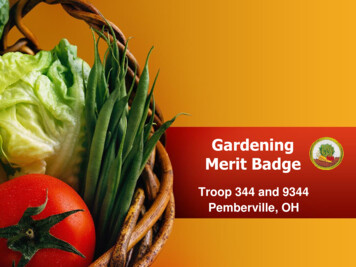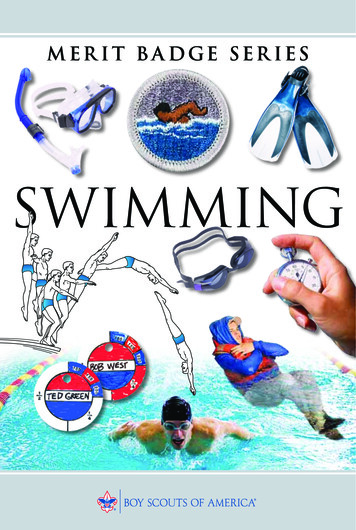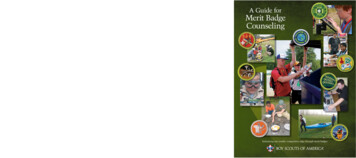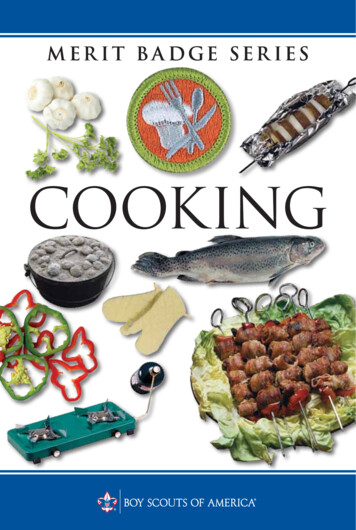
Transcription
COOKING
How to Use This Pa mphletThe secret to successfully earning a merit badge is for you to use boththe pamphlet and the suggestions of your counselor.Your counselor can be as important to you as a coach is to an athlete.Use all of the resources your counselor can make available to you.This may be the best chance you will have to learn about this particularsubject. Make it count.If you or your counselor feels that any information in this pamphlet isincorrect, please let us know. Please state your source of information.Merit badge pamphlets are reprinted annually and requirementsupdated regularly. Your suggestions for improvement are welcome.Send comments along with a brief statement about yourself to YouthDevelopment, S209 Boy Scouts of America 1325 West Walnut HillLane P.O. Box 152079 Irving, TX 75015-2079.Who Pays for This Pa mphlet?This merit badge pamphlet is one in a series of more than 100 coveringall kinds of hobby and career subjects. It is made available for youto buy as a service of the national and local councils, Boy Scouts ofAmerica. The costs of the development, writing, and editing of themerit badge pamphlets are paid for by the Boy Scouts of America inorder to bring you the best book at a reasonable price.
BOY SCOUTS OF AMERICAMERIT BADGE SERIESCOOKING
Requirements1. Do the following:a. Review with your counselor the injuries that might arise fromcooking, including burns and scalds, and the proper treatment.b. Describe how meat, fish, chicken, eggs, dairy products, andfresh vegetables should be stored, transported, and properlyprepared for cooking.c. Describe the following food-related illnesses and tell what youcan do to help prevent each from happening:(1) Salmonella enteritis(2) Staphylococcal enteritis(3) Escherichia coli enteritis (E. coli)(4) Botulism(5) Trichinosis(6) Hepatitis2. Do the following:a. Illustrate for your counselor the food pyramid that fits you.Label the following food groups in the pyramid and how muchof each you should eat each day:(1) Grains(2) Vegetables(3) Fruits(4) Milk, yogurt, cheese(5) Meats, poultry, fish, beans, eggs, nuts(6) Oils (fats) and sugarsb. Explain why you should limit yourintake of oils and sugars.c. Explain the number of servingsrecommended per day from each group.35879ISBN 978-0-8395-3349-8 2007 Boy Scouts of America2010 PrintingBANG/Brainerd, MN5-2010/060099
d. Give your counselor examples from each food group.e. Describe for your counselor the measurements of servings foreach food group.f. Describe to your counselor food preparation techniques thatresult in more healthful and nutritious meals.3. Plan a menu for two straight days (six meals) of camping. Includethe following:a. A camp dinner with soup; meat, fish, poultry, or an appropriatesubstitute; two fresh vegetables; drink; and dessert. All are tobe properly prepared. When preparing your menu, follow thenutritional guidelines set by the food pyramid.b. A one-pot dinner. Use foods other than canned.c. Using the menu planned for requirement 3, make a food listshowing cost and amount needed to feed three or more boys.d. List the utensils needed to cook and serve these meals.4. Using the menu planned for requirement 3, do the following anddiscuss the process with your merit badge counselor:a. Prepare and serve for yourself and two others, the two dinners,one lunch, and one breakfast. Time your cooking so that eachcourse will be ready to serve at the proper time.*b. For meals prepared in requirement 4a for which a fire is needed,use a lightweight stove or build a low-impact fire. Include support for your cooking utensils from rocks, logs, or like material.The same fireplace may be used for more than one meal. Use abackpacking stove to cook at least one meal. (Where localregulations do not allow you to do this, the counselor maychange the requirement to meet the law.)c. For each meal prepared in requirement 4a, use safe food-handlingpractices. Dispose of garbage, cans, foil, paper, and other rubbishby packing them out and depositing them in a proper container.After each meal, clean up the site thoroughly.5. Plan a menu for one day (three meals) or for four meals over atwo-day period of trail hiking or backpacking. Include the following:a. A breakfast, lunch, and dinner for a trail or backpacking tripwhere light weight is important. You should be able to storeall foods used for several days without refrigeration. Whenpreparing your menu, follow the nutritional guidelines set bythe food pyramid.*The meals in requirements 4a and 6a may be prepared for different trips.They need not be prepared consecutively. Scouts working on this badge insummer camp should plan around food they can get at the camp commissary.COOKING3
b. Using the menu planned for requirement 5, make a food listshowing cost and amount needed to feed three or more boys.c. List the utensils needed to cook and serve these meals.d. Figure the weight of the foods in requirement 5a.6. Using the menu planned for requirement 5, do the following:a. Prepare and serve for yourself and two others the trail breakfastand dinner. Time your cooking so that each course will be readyto serve at the proper time.*b. Use an approved trail stove (with proper supervision) or charcoalto prepare your meals.c. For each meal prepared in requirement 6a, use safe food-handlingpractices. Dispose of garbage, cans, foil, paper, and other rubbishby packing them out and depositing them in a proper container.After each meal, clean up the site thoroughly.7. Plan a menu for three full days of meals (breakfast, lunch, anddinner) to be cooked at home.a. When preparing your menu, follow the nutritional guidelinesset by the food pyramid. All meals are to be cooked orproperly prepared.b. Using the menu planned for requirement 7, make a food listshowing cost and amount needed to feed yourself and atleast one adult (parent, family member, guardian, or otherresponsible adult).c. Tell what utensils were needed to cook and serve these meals.d. Prepare and serve a breakfast, lunch, and dinner from the menuyou planned for requirement 7. Time your cooking to have eachcourse ready to serve at the proper time. Have an adult verifythe preparation of the meal to your counselor.8. Find out about three career opportunities in cooking. Pick one andfind out the education, training, and experience required for thisprofession. Discuss this with your counselor, and explain why thisprofession might interest you.*The meals in requirements 4a and 6a may be prepared for different trips. They need notbe prepared consecutively. Scouts working on this badge in summer camp should planaround food they can get at the camp commissary.4COOKING
ContentsCooking Basics . . . . . . . . . . . . . . . . . . . . . . . . . . . . . . . . . . . 7Planning and Preparing Meals at Home . . . . . . . . . . . . . . . . 21Planning and Preparing for Camp Cooking . . . . . . . . . . . . . . 29Get to Know Your Food Groups . . . . . . . . . . . . . . . . . . . . . . 49Food Service as a Career . . . . . . . . . . . . . . . . . . . . . . . . . . . 59Menus and Recipes . . . . . . . . . . . . . . . . . . . . . . . . . . . . . . . 63The Cook’s Glossary . . . . . . . . . . . . . . . . . . . . . . . . . . . . . . 92Resources for Cooking . . . . . . . . . . . . . . . . . . . . . . . . . . . . . 94
.Cooking BasicsCooking BasicsMost people appreciate good food and the comfort of adelicious home-cooked meal. Many Scouts know the fun ofenjoying a tasty cookout after a rigorous day in the outdoors.Cooking is a skill you can learn now and enjoy for life.With a little planning and practice, you can easily turneveryday ingredients into a healthy meal. Learning to cookgives you new respect for those who have prepared meals foryou. Best of all, cooking is fun and rewarding, too—especiallywhen the compliments pour in and you hear requests forsecond helpings.The Cooking merit badge will introduce you to principlesof cooking that can be used both at home or in the outdoors.You will learn about food safety, nutritional guidelines, mealplanning, and methods of food preparation. This pamphletincludes recipes that can be used either at camp or at home.It also offers a look into the variety of culinary (or cooking)careers available. So, let’s get cooking!It is hard to beatthe satisfaction ofpreparing greatfood for yourselfand your familyand friends.From the grocery store tothe plate, making meals forcookouts or at home takesplanning. As you cook,remember to keep safetyas your top priority. Byplanning carefully andcooking with a varietyof foods, you will helpmake the mealtimeenjoyable for you andthose for whomyou cook.COOKING7
Cooking Basics.Cook SafelySafety is always a Scout’s primary consideration. Along with considering the gear needed, the environment, and any necessaryprotection from the elements, the first consideration in preparingfor this trip would be the safety of the patrol members. Cookingalso requires planning and attention to detail to keep safety first.A simple definition of cooking can be putting together threeitems—uncooked food, utensils, and heat—and creating ediblenourishment. All three elements contain the potential for injury.Never grab a pothandle withoutfirst protectingyour hands.FoodThe first item involved in safe cooking is, of course, the food.Meats and dairy foods must be kept cold before use. Onceremoved from its protective wrapper, meat must be kept separate from other food items. Because bacteria can grow in meat,the meat must be cooked as soon as it is no longer cold.Likewise, any uneaten, cooked meat must be properly storedand kept cold to eliminate the risk of growing bacteria.UtensilsCooks use many types of equipment to prepare food. Sharpknives must be used properly to prevent serious cuts andinjuries. Pots on a stove or campfire get extremely hot andalways must be handled with hot-pot tongs or hot pads toprevent burns.Some pots are very thick and heavy by design, suchas the Dutch oven. Cooks must always transport theseheavy pots carefully. Dropping such a pot, even an emptypot, could cause serious injury if it landed on someone.8COOKING
.Cooking BasicsHeatWhether cooking over a fire in camp or on a stove at home,there is always a risk to you, to others nearby, and to yourenvironment. In camp, follow all safety guidelines describedin building and using a campfire or camp stove.Cook under adult supervision when you are using a stoveor grilling outside. Both electric and gas stoves and grills present unique risks; understand the fuel your cooking applianceuses. Keep your stove and oven clean and neat. Do not placepot holders or dish towels on the stove, even for a moment.Dress appropriately while cooking. Remove jewelry thatcan dangle or catch on a pot. Avoid wearing loose clothingand, for sanitary and safety reasons, tie back long hair.Do not use anoutdoor grill insidethe house orgarage, or nearoverhangingbranches outside.EXERCISING FIRE SAFETY AWARENESSResidences are required by law to have a workingfire alarm, or smoke detector. A fire alarm emits avery loud siren to alert occupants when smoke ispresent. These alarms typically are installed onthe ceiling, where smoke can first be detected.A fire extinguisher is a must in thewell-equipped kitchen. Learn how touse yours before an accident occurs.Understand how smoke detectors work. Make sure to changetheir batteries regularly, such as during a springtime holidayand again during a fall holiday.COOKING9
Cooking Basics.First Aid and Prevention of CommonCooking InjuriesFollowing these safety guidelines won’t eliminate your risk of acooking injury but will help prepare you in case of an accident.Basic first-aid techniques can be used if someone gets injuredwhile cooking.A first-aid kit is useful for treating injuries, but rely first on safetyand prevention.Common Cooking InjuriesDo not allowfriends and otherdistractionsto divert yourattention whileyou are cooking.Here are some common injuries that can take place while cooking.Burns and Scalds. Burns are caused by contact with flame,hot objects, chemicals, electrical sources, radiated heat, frozensurfaces, friction, or radiation. Scalds are burns caused by contact with boiling fluids or steam. Treatment for minor burnsand scalds is the same.Step 1—Stop the burn. Put out flames or remove the victimfrom the source of the burn. The terrible thing about burns isthat the skin continues to burn and more damage is createduntil you can cool down the affected area of the person’s body.Step 2—Cool the burn. Use large amounts of cool water tocool the burn. Never use ice except on small, superficial burns,because it causes body heat loss. If the area cannot be immersed,like the face, soak a clean cloth in cool water and apply it gentlyto the burn. Continue adding water to keep the cloth cool.Step 3—Cover the burn. Use dry, sterile dressings or a cleancloth to help prevent infection. Bandage loosely so that air canflow around the wound; this will help the area heal morequickly. Apply an antibiotic ointment only to minor burns.Do not use home remedies, and do not break blisters.10COOKING
.Cooking BasicsFor minor (first-degree, second-degree) burns that are notsevere enough to require medical attention, wash the burnedarea with soap and water. Keep the wound clean, and applyan antibiotic ointment for the first few days. Some people maybe allergic to topical ointments; if you have any doubts, calla doctor.For severe (third-degree) burns, seek medical treatmentas quickly as possible. Severe burns can be a life-threateninginjury. Unless the victim is having trouble breathing, have thevictim lie down. Try to raise the burned areas above the level ofthe victim’s heart if possible, and protect the victim from drafts.Preventing Burn InjuriesThese simple precautions will help any cook preventburn injuries. Take time toprepare mealswithout rushing. Always use potholders that are ingood repair.Because theycan cause falls,avoid using arearugs in the kitchen,especially nearthe stove. Keep pot handlesturned toward theback of the stove. Cook on rear burners whenever possible, but avoidreaching over an open flame or hot burner. Use caution when moving heavy pots of hot liquidsfrom the stove. Keep all heated liquid and food out of children’sreach, and never hold anything hot while carryinga child. While cooking, try to keep younger children out ofthe kitchen. Remove tablecloths when toddlers are present (theycan pull the table’s contents on top of themselves). Purchase and use small appliances with shortelectrical cords.COOKING11
Cooking Basics.Cuts. Follow these steps to treat minor cuts.Step 1—Stop the bleeding. Apply pressure with a clean,absorbent cloth or your fingers. (Wear latex gloves.)Step 2—If the blood soaks through, apply a secondbandage on top. Leave the first bandage on to preservethe clotting that has already taken place.Step 3—If the bleeding continues, raise the wound above thepatient’s heart level.Never put knivesin the dishwasher.It is easy to missseeing the knivesand get cutwhen unloadingthe dishwasher.Step 4—Once bleeding stops, clean the wound gently withsoap and water, or just flush the wound with water to removeall debris and dirt.Step 5—Apply an antibiotic ointment. Some people areallergic to these ointments; ask the patient or contact a doctorif you have any doubts. Cover the cut with a clean bandage.Preventing CutsHelp prevent accidents bypracticing these safety tips. Keep knives and scissorssharp and handlethem carefully. Store sharp itemsseparate from otherutensils. Take them outof storage only whenthey are being used. Never put knives orscissors in a sink full ofwater. Wash, rinse, dry, and put them away as you go. When you use a knife to cut, dice, or chop, alwaysplace the item you are cutting on a flat surface suchas a wooden cutting board. Cut away from yourself,making sure your fingers are not in the knife’s path.The first step in treating a minor cut is to apply pressure tothe wound with a clean, absorbent cloth.12COOKING
.Cooking BasicsSmoke Inhalation. Inhaling smoke can seriously damage thelungs, and smoke sometimes contains noxious fumes. To treata smoke inhalation victim, first remove the victim from thesmoke-filled area. Then have the victim take long, deep breathsof fresh air to clear the lungs.If coughing or choking continues, or if there is pain,irritation, or raspy breathing, see a doctor as soon as possible.Clean as You GoDevelop good habits in the kitchen.Clean pans, pots, utensils, andyour working surfaces as you go.Dishes are easier to wash whenyou clean them soon after you usethem. Keeping the home or campkitchen clean as you cook hasother advantages. It keeps the cooking area safer. It makes your cooking experiencecalmer and more organized. It makes cleanup a breezewhen you are finished cookingand eating.It is no fun when you havemuffins ready to come out of theoven and you cannot find a potholder because it was not put backwhere it belongs. If you use what ishandy, such as a dish towel, youstand a good chance of getting burned. Cleaning andputting things back where they belong as you go willeliminate these hassles because everything will be inits place when you need it.Make sure the work area is clean anduncluttered before you begin, andkeep it clean as you go. Have all theingredients, utensils, pots, and pansready before you start to cook.COOKING13
Cooking Basics.As you cook, you often need to reuse the sameequipment. For example, you might use a mixerfor the cake batter, so clean the mixer blades rightaway because you will need them as soon as thecake cools to make frosting.Always use an antibacterial cleaner to wipe up spills frommeat packaging or from raw meat. Do not cut meat on thesame surface you use to cut up vegetables and other foods,even if the surface is clean.Use an antibacterial cleaner to keepkitchen countertops clean.Store food in tightly sealed containers.To plan ahead and minimize cleanup as much as possible,keep a sink about half full of warm, soapy water while preparing meals. This makes it quick and easy to keep your handsclean as you work with various foods, such as raw meats.Sweep up and dispose of broken glass carefully. Putthe broken pieces inside a small paper bag or smallempty box before putting it into the trash bag to helpprevent injury to the person who handles the trash.14COOKING
.Cooking BasicsAvoid overstockingthe refrigerator;an overstuffedfridge will notkeep foodcold enough.Safe Food Storage and TransportationWhen storing and handling food, these simple rules will helpkeep the kitchen—and your cooking—safe. Keep cold foods cold and hot foods hot. For camp, keep coldfood on ice in a cooler. When you buy food in jars, make sure the safety seal on thelid is intact. Freeze any fresh poultry or meatthat will not be used within twodays. Follow any label instructionsfor storage.Proper food storage helpsprevent bacteria from forming. Refrigerate any leftovers assoon as the meal is over. Usesmaller containers to coolleftovers quickly; slow coolingencourages bacteria growth. Keep the refrigerator clean,and discard uneaten leftoversafter three days.COOKING15
Cooking Basics.Stoves and Other AppliancesBefore you cook,learn about anyappliances youwill be using. Ifyou are cookingwith a gas stoveMost Scouts know about the risks involved in using fire in theoutdoors. These risks carry over to any kind of cooking anywhere,no matter what the “fire” looks like. For example, even thoughyou do not see fire when the microwave is operating correctly, theelectricity used to run it is basically the same as a campfire. If youuse a microwave oven to reheat leftovers for lunch, you probablyknow that having anything metal (like aluminum foil) in themicrowave while it operates may cause an electrical fire.while camping,read themanufacturer’sinstructions anduse only withadult supervision.Be sure all partsare in goodworking order.Never use aluminum foil to cover food in a microwave oven.Always cook under an adult’s supervision. Ask an adultto explain the stove’s operation; gas stoves and electric stovesoperate very differently and have different risks.General Food-Related Illnesses andPrevention GuidelinesThere are simple ways to reduce the risk of food-related illnesses. Always follow the food-storage guidelines described inthis chapter. Wash your hands with soap and warm water before cooking,after cooking, as needed while you cook, and before eating.Camp stove Keep your work area clean; wipe up spills quickly andthoroughly using soap and water or kitchen cleaner. Cook all meat and poultry products, including eggs,thoroughly before eating. Never eat raw cookie dough or cake batter. Never use foods from cans that bulge.16COOKING
.Cooking BasicsWash your hands with soap and water before handling food.Failure to follow safe food-handling guidelines can causeserious illness. Here are a few illnesses worth mentioning.Salmonella Enteritis. This bacteria is linked to raw, uncookedeggs and poultry, and unwashed, raw vegetables and fruits.Salmonella poisoning symptoms include nausea, vomiting,fever, abdominal pain, diarrhea, dehydration, weakness, andloss of appetite.Help prevent salmonella poisoning by doing the following. Do not buy leaking packages; isolate meat packages in plastic bags to prevent contaminating other foods. Prepare foods using clean utensils and clean work surfaces. Quickly wipe up all raw meat or poultry juices from counters, and wash utensils, hands, cutting boards, and servingplates that are exposed to such juices. Thoroughly cook all foods derived from animals(including eggs). Do not eat raw eggs, cookie dough,or cake batter. Consume onlypasteurized milk products. Thoroughly wash all fruitsand vegetables. Refrigerate leftovers promptly.
Cooking Basics.Staphylococcal Enteritis. This bacteria multiplies in warmtemperatures and thrives on protein. Symptoms of infectioninclude nausea, vomiting, diarrhea, headache, fever, chills,weakness, and dizziness.To prevent staphylococcal enteritis, wash hands and utensilsbefore serving food. Thoroughly cook all meats, and refrigerateleftovers promptly in shallow, covered containers.Escherichia Coli Enteritis (E. Coli). This is a bacteria thatattacks the intestinal tract. It can be transmitted person toperson and grows at temperatures of 44 degrees and above.In extreme cases, it can cause serious complications in childrenand elderly people. Symptoms include abdominal cramps,diarrhea, nausea, vomiting, and fever.Take these precautions to prevent the spread of E. coli. Prepare and store food in a sanitary environment. Thoroughly cook all food. Refrigerate food at 40 degrees or below.Botulism. This deadly disease is caused by ingestingbacteria that can be found in many kinds of food.Symptoms include dry mouth, double vision, nausea,diarrhea, vomiting, abdominal cramps, sore throat,dizziness, constipation, weakness, muscle paralysis,and difficulty swallowing or breathing.18COOKING
.Cooking BasicsTake these precautions to prevent thespread of botulism. Never use food from damaged orbulging containers or foods that havea strange odor or appearance. Cool leftovers quickly by storing themin shallow, small containers. Reheat all refrigerated foods.Trichinosis. Trichinosis is caused by the parasite Trichinellaspiralis. Its larvae can remain alive in human tissue foryears. People contract trichinosis by eating undercookedor raw meat, especially pork infected with the parasite.Infection usually occurs without symptoms, which can includestomachache, nausea, vomiting, and diarrhea. When there aresymptoms, they occur during the first week after swallowingthe organism. To prevent trichinosis, thoroughly cook meats,especially pork.Hepatitis. Hepatitis A is one of five viruses known to causeinflammation of the liver, the others being hepatitis B, C, D,and E. Hepatitis A is usually a mild illness characterizedby sudden onset of fever, malaise, nausea, and abdominaldiscomfort, followed in several days by jaundice. Patientswith anorexia often may have hepatitis A.A vaccine can prevent hepatitis A in many cases. Childrenages 1 to 18 years old should receive two initial doses of thevaccine and booster shots after six and 12 months. Adultsshould get an initial dose and then a booster six to 12 monthslater. It takes at least two weeks before protection can takeeffect. The illness also can be prevented by a shot of immuneglobulin within two weeks of exposure. To help prevent hepatitis A, do the following.Knowing the basictools of cookingand practicingsafe food-handlingand preparationtechniques givesthe beginner cooka solid foundation.Staying safe whilehandling food andequipment shouldbe a Scout’stop priority. Wash hands with soap and warmwater before preparing and eatingfood. Make sure to use a nailbrushto scrub under your fingernails,where bacteria can hide. Cook shellfish thoroughly before eating. Drink water from approved sources only. Keep bathrooms clean and disinfected.COOKING19
Always use appliances with an adult’s supervision.
.Planning and Preparing Meals at HomePlanning and PreparingMeals at HomeGood planning and preparation before you start cooking will helpyou successfully prepare healthy and delicious meals at home.1. Determine when you will be cooking and the types of mealsyou will be preparing.2. Find out whom you will be cooking for and whether anyonehas any special dietary needs.3. Select recipes using the food pyramid (discussed later on)as a guideline.Practicing anddeveloping yourcooking style willhelp you gainthe confidenceyou need toprepare a varietyof tasty meals.4. Make a list of foods required for the meals, then create ashopping list based on the ingredients you will need.5. Create and follow a timetable for the preparation of each meal.Understanding the EquipmentBefore you cook at home, understand yourcooking equipment, including appliances,utensils, pots, and pans. Appliances includethe stove and oven, microwave, refrigerator,and garbage disposal, plus any small appliancessuch as a food processor, blender, and electricmixer. All these appliances serve a function inthe food preparation process, and care must betaken in operating these appliances correctly.For instance, food processors and blendershave very powerful and sharp blades that can chop,puree, and liquefy foods. Use them only for foods recommended by the manufacturer. Always make sure the top isfirmly locked in place before operating a food processor orblender. Most food processors have safety features that preventthe appliance from operating unless the top is secure.COOKING21
Planning and Preparing Meals at Home.Cooking With a Microwave OvenA microwave oven is a great time-saver, especially with simplemeals. Baked potatoes, which take at least 45 minutes in aconventional oven or over a campfire, cook in just a fewminutes in the microwave. Covering bacon slices thickly 23withpaper towels and cooking them on a plate in the microwave ismuch easier than pan-frying bacon. Reheating tortillas takesonly about 30 seconds in the microwave; in a conventionaloven, it might take 10 to 15 minutes.Take special precautions when using a microwaveoven. Wear oven mitts and handle microwave dishes withextreme care. Read and follow the user’smanual, and follow theinstructions when preparingpackaged foods. Avoid using glass containers,which can get very hot. Puncture plastic wrap beforeheating foods, and stir foodsduring cooking to distributethe heat.Be careful when eating foods with filling—the filling may be very hot, even though theouter portion feels lukewarm. To avoid steam burns, protectyour hands and forearmswhen removing the coverfrom a hot dish. Never heat baby formula orbaby food in a microwave.Often, it is better to heat something up in a pan on thestove. For example, the microwave does not work as wellfor browning foods. Heat permeates food rather than beingconcentrated on the surface next to the heating element, as inconventional cooking. As a result, food does not brown fromclose contact with the heat source.Some foods change in texture when cooked in a microwave.For example, potatoes baked in an oven or on the coals have acrisp shell and dry, fluffy interiors that some people prefer tothe softer, steamier microwaved potato.22COOKING
.Planning MealsWhen shopping for your familymeals, always consider your family’sbudget. An adult at home can helpyou determine how much to spendand how to stay within budget.Frozen fruits and vegetables are the next best thing to fresh duringthe winter months when some fruits and vegetables are not inseason or are more expensive.Buying in bulk and freezing portions of ingredients(such as fresh meats and poultry) often cuts per-unitcosts, saving money in the long run. When freezingfresh meats, remove them from their original packagingand wrap recipe-sized portions tightly in freezer wrap orresealable plastic freezer bags.If you plan wisely, you should not have many leftovers—unless you want leftovers. For example, if you make a big potof chowder, you may want to serve it for dinner, refrigerate it,and have some the next day. You also might freeze a portion toenjoy later on.Always look at the servings or yield any recipe promises,for example, “serves four.” From there, the recipe can beincreased for a larger crowd or decreased for only a coupleof people. Just double the amount of ingredients listed to cookfor twice the number of people the recipe serves, or halve theingredients for just two people.One of the manyfreedoms ofcooking at homeis the availabilityof refrigeration.Many frozen foodsare available thatmake cookingeasier or, in somecases, makerecipes possibleat all.This chart will help you adjust the yield of your recipe.Measurements1 4 teaspoon1 teaspoon1 tablespoon2 tablespoons4 tablespoons8 tablespo
This merit badge pamphlet is one in a series of mor e than 1 00 c ov ering all kinds of hobb y and car eer subjects . It is made av ailable for y ou to buy as a service of the national and local councils , Bo y Scouts of America. Th
